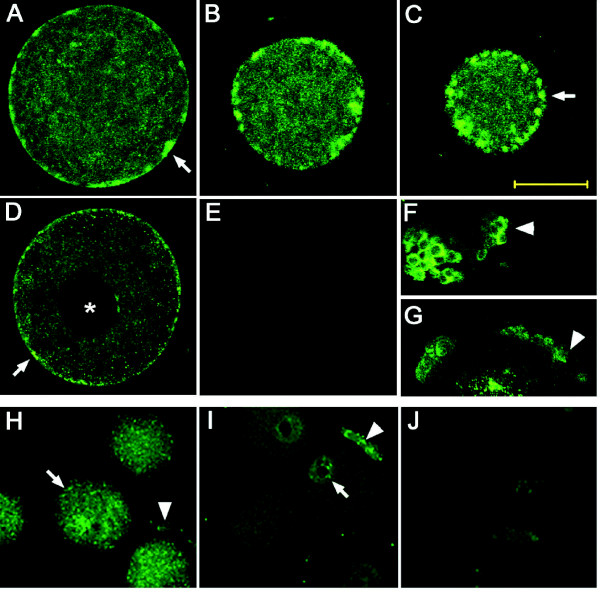Figure 2.
Immunofluorescent detection of EP receptor proteins (green) in monkey and mouse oocytes. Panels A-C. EP2 immunofluorescence in representative serial sections through a single monkey oocyte demonstrating concentration of fluorescence at the plasma membrane (arrows), with diffuse central staining. Panel D. EP4 immunofluorescence was present primarily concentrated at the monkey oocyte plasma membrane, with limited central fluorescence; germinal vesicle did not stain as indicated with an asterisk (*). Immunofluorescent detection of EP2 (F) and EP4 (G) in monkey cumulus granulosa cells is indicated by arrowheads. Immunofluorescence was reduced when primary antibody for EP2 (Panel E) or EP4 (not shown) was preabsorbed with the antigenic peptide. Omission of a primary antibody resulted in no staining (not shown). Panels H-J. Immunodetection of EP2 (H) and EP4 (I) in mouse oocytes (arrows) and surrounding cumulus (arrowheads). Immunofluorescence representing detection of EP2 was observed throughout the oocyte cytoplasm, while EP4 immunofluorescence was concentrated near the germinal vesicle (GV). Immunofluorescence was reduced in both oocytes and cumulus when the primary antibody for EP2 (J) or EP4 (not shown) was preabsorbed with the antigenic peptide; omission of the primary antibody yielded very low staining (not shown). For both species, images are representative of a minimum of 2 oocytes from a minimum of 3 different animals. Bar in Panel C = 50 μm and should be used for all Panels.

